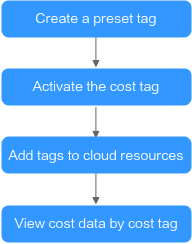Cost Management
This section describes how to manage your cost composition, allocation, analysis, and optimization.
Cost Composition
There are three ServiceStage cost components.
- Product edition: ServiceStage comes in basic and professional editions.
- Number of application instances: You will be billed on the number of application instances running on ServiceStage.
- Usage duration: You will be billed on the usage duration (in hour and accurate to seconds).
ServiceStage billing does not include computing resources (Cloud Container Engine (CCE) and Elastic Cloud Server (ECS)), network resources (Elastic Load Balance (ELB) and Elastic Public Network EIP)), middleware (Cloud Service Engine (CSE), Distributed Cache Service (DCS), and Cloud Database Service (RDS)), and storage resources (Software Repository (SWR), Object Storage Service (OBS), and CodeArts Repo).
Cost Allocation
A good cost accountability system ensures that departments, business teams, and owners are accountable for their respective cloud costs. Allocate costs to different teams or projects so that organizations have a clear picture of their respective costs.
Huawei Cloud Cost Center provides multiple tools for cost collection and reallocation. Choose to allocate costs by:
- Linked account
The enterprise master account categorizes the costs of its member accounts to manage the accounting of these accounts. For details, see Viewing Costs by Linked Account.
- Cost tag
Huawei Cloud assigns sorting tags such as purpose, owner, or environment, to your cloud resources. These are the four steps for managing costs by predefined tags.

For details, see Viewing Costs by Cost Tag.
- Cost category
Cost Categories provided by Cost Center help you split shared costs. Shared costs include the costs for resources (compute network, storage, or resource packages) shared across departments, and costs that cannot be directly split by cost tag or enterprise project configured for the resources. These costs are not directly attributable to a singular owner, and hence cannot be categorized into a singular cost category. In this case, define cost splitting rules to fairly allocate these costs among teams or business units. For details, see Viewing Costs By Cost Category.
Cost Analysis
To accurately control and optimize your costs, you need a clear understanding of what parts of your enterprise incurred different costs. Cost Center visualizes your original costs or amortized costs using various dimensions and display filters. Analyze the trends and drivers of your service usage and costs from a variety of perspectives and scopes.
Cost Anomaly Detection provided by Cost Center also detects unexpected expenses promptly for tracing, monitoring, and analysis. For details, see Performing Cost Analysis to Explore Costs and Usage and Enabling Cost Anomaly Detection to Identify Anomalies.
Cost Optimization
ServiceStage is billed pay-per-use.
Pay-per-use is useful when application instances do not need to run 24/7, or only for a short period of time.
Choose a product edition and billing mode as required after subscribing. If you use the basic edition and run less than or equal to 20 application instances, ServiceStage is free of charge. If you run more than 20 application instances, you are billed on the actual number (up to 100) of running application instances.
Feedback
Was this page helpful?
Provide feedbackThank you very much for your feedback. We will continue working to improve the documentation.See the reply and handling status in My Cloud VOC.
For any further questions, feel free to contact us through the chatbot.
Chatbot





